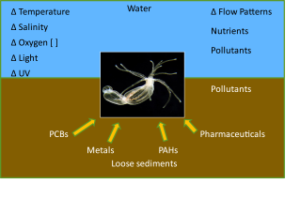Responding to a Changing World
All animals must sense and respond to changes in their environment…and in some cases the environments are changing quickly and dramatically. Some targets of current and recent research are the role of mixotrophy in supporting temperate food webs, and molecular responses of the sea anemone Nematostella to diverse physical and chemical stressors.
Mixtrophy, broadly defined as utilizing different sources of energy and carbon, can provide metabolic flexibility and allow organisms to persist and thrive in otherwise challenging environments. We are specifically interested in algae that combine photosynthesis with the consumption of food particles, and the consequences of these different metabolic modes for their nutritional value to zooplankton consumers. At times, (e.g., during seasonal stratification) nutrients may be stripped from the upper water column, limiting the growth of strictly photosynthetic organisms (autotrophy), and leading to poor nutritional quality of the available autotrophs. Under these conditions, protists that can supplement photosynthesis with particulate feeding (mixotrophy) may be outcompete autotrophs and be of higher nutritional quality. In 2023, we will be starting field studies and experiments for a new NSF-funded project aimed at testing these hypotheses. We will investigate the extent to which mixotrophs can support copepod reproduction under conditions when phototrophic food is of poor quality, and we will assess mixotrophic contributions to the diet of two abundant copepod species within the Gulf of Maine.
(See also a quirky blog post from when I was working on this proposal during the COVID lockdown)
 Nematostella is a remarkably tough little sea anemone. Naturally found in salt marsh habitats, it can tolerate nearly fresh to hypersaline water and natural temperature swings of over 20 °C within a day. It can survive low levels of oxygen, high levels of pollutants, and extended periods of starvation. We’re interested in how this little anemone is able to so readily adapt its physiology to dynamic and extreme conditions. Some of our recent and continuing work has focused on responses to Nematostella to oil and oil-derived pollutants. We’ve found that Nematostella appears to relatively tolerant of oil exposure, but are potentially vulnerable to damage by UV radiation and phototoxicity of UV-exposed contaminants. Papers: Berger et al, 2022, Tarrant et al. 2018, Blog: UV and Weathered Oild are (more than) Double Trouble for 'Stella.
Nematostella is a remarkably tough little sea anemone. Naturally found in salt marsh habitats, it can tolerate nearly fresh to hypersaline water and natural temperature swings of over 20 °C within a day. It can survive low levels of oxygen, high levels of pollutants, and extended periods of starvation. We’re interested in how this little anemone is able to so readily adapt its physiology to dynamic and extreme conditions. Some of our recent and continuing work has focused on responses to Nematostella to oil and oil-derived pollutants. We’ve found that Nematostella appears to relatively tolerant of oil exposure, but are potentially vulnerable to damage by UV radiation and phototoxicity of UV-exposed contaminants. Papers: Berger et al, 2022, Tarrant et al. 2018, Blog: UV and Weathered Oild are (more than) Double Trouble for 'Stella.
We’ve also conducted some intriguing (I think) studies of genetic and physiological components of thermal tolerance in Nematostella. Anemone populations collected from different locations have different themal tolerances that appear to be genetically driven, and the thermal tolerance of individuals can shift as the acclimate to local conditions. We have also found that the thermal tolerance of larval anemones is related both to the parental population (genetic effects) and the temperatures experienced by the parents shortly before spawning (parental affects; plasticity). We are interested in discovering the mechanisms that enable these parental effects. Papers: Rivera et al. 2021, Reitzel et al. 2013.